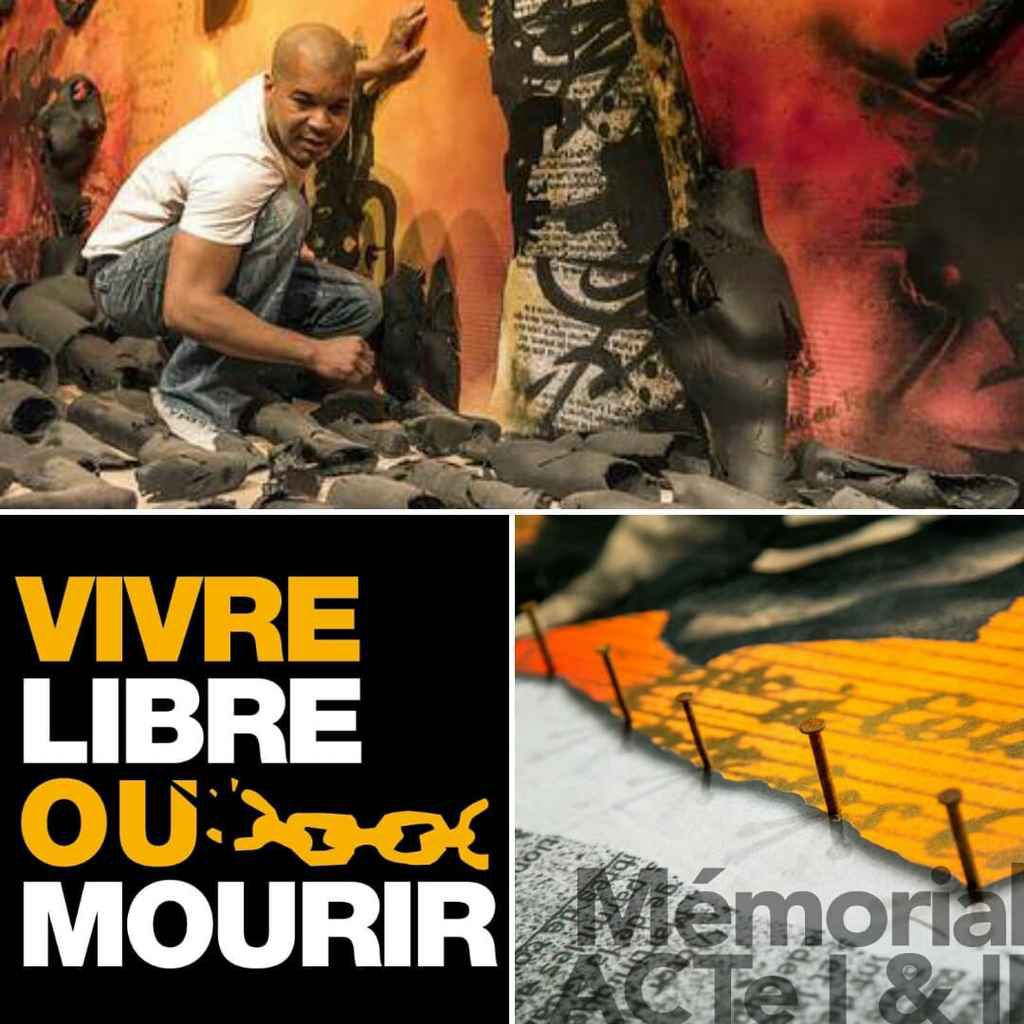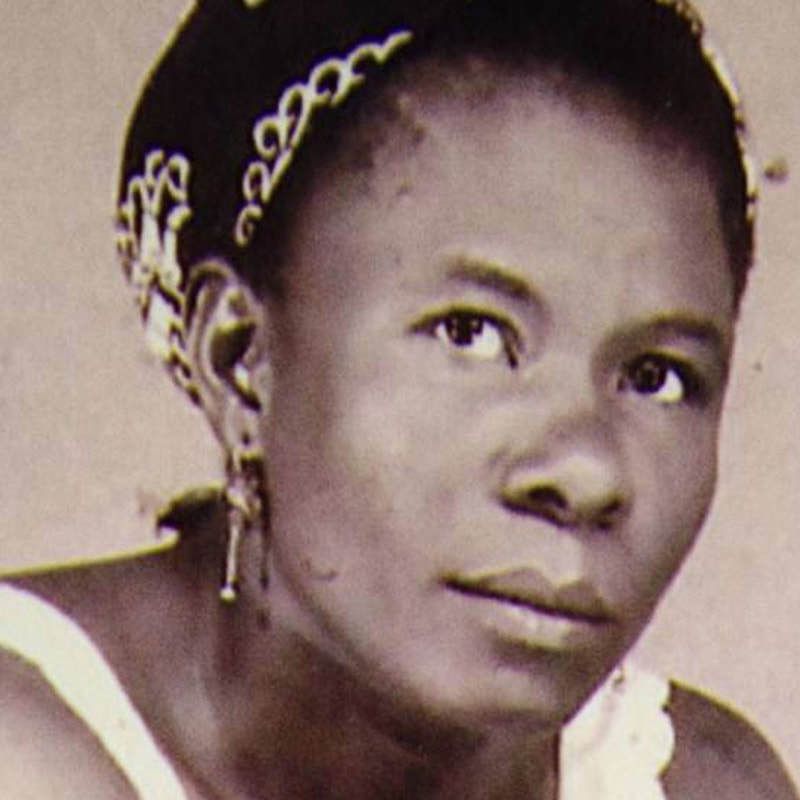society
LIVE FREE OR DIE!! From Pointe à Pitre, to Unesco and beyond...
On the 8th June 2018 at Unesco in partnership with its « Slave Route » project, the founders of the "Vivre Libre ou Mourir" initiative, namely Shuck One from Guadeloupe and Emily Gonneau, French-British, representing Unicum Music, launched the first ever vinyl album connected to an app (out since the 27th May 2018) dedicated to the memory of the translatlantic slave trade.
The vynil is linked to Shuck One’s visual art installation "L"histoire en marche - History Marching" and composer Maxime Lenik’s sound illustration of it. The work of art was commissioned by the French State and is part of the permanent collection at the Memorial ACTe in Pointe à Pitre, Guadeloupe.
Thanks to the vynil, many more will now be able to remotely explore the work exposed wherever they are on the planet. The vinyl is like any other vinyl that you play on a standard turntable, yet when you scan it with a smartphone (even through the album cover) it uses NFC technology to connect you to a platform hosting :
- the tracks on the vinyl as well as bonus featuring Lilian Thuram
- the biographies of the Shuck One and Maxime Lenik, the art installation’s co-creators
- videos about Shuck One’s 'History in the making'
- content provided by UNESCO from its « Slave Route » project
- updates and news on the topic concerning the duty of memory of the transatlantic slave trade
In order for the user’s experience of the project may happen over a long period of time, new content will progressively be uploaded onto the app on a monthly basis, such as :
- educational videos
- videos exploring the creative process
- interviews with personalities about the importance of the Transatlantic Slave Trade’s impact on our collective memory today and beyond
- presentation of the tools and material used to compose
Continue to read for more info on the project "Vivre Libre ou Mourir"
How did it all begin?
It all started in 2015 when Shuck One, a visual and street art artist was commissionned to create a visual installation for the Memorial ACTe in Pointe à Pitre, Guadeloupe called "L'Histoire en Marche".
This fine arts project pays hommage to the fight for Freedom against Napoleon Bonaparte's troops which came to Guadeloupe to reestablish slavery in 1801, initiated and led by Joseph Ignace and Louis Delgres. It is a contemporary reflection of the 21st century concerning a page of History which is still being written today through ongoing research for which perception must continue to contribute to the collective conscience.
It consists in a composition in volume with the intervention of different techniques: acrylic, aerosol, magic-marker, collages of heteroclitic elements. The work in volume is conceived from a vintage map of Guadeloupe which traces a topography of confrontation. With regard to this topography, a chronology of the conflict is integrated in the form of collages.The work invites us to stride in the wake of the resistance, its path on a factual and physical dimension with the integration in volume of dismembered bodies, charred projections of flesh with gunpowder impactions; the extreme violence with which the insurgents faced the men of Richepance is palpable. The movements of Ignace and Delgrès' troops become charged with a mental and ideological dimension, notably signified by Delgrès' declaration of May 10th 1802, cited and presented in collage form: « LIVE FREE OR DIE! » its relevance is universal!
This visual installation is complemented by a sound installation composed by Maxime Lenik and interpreted by Yorrick Troman. See link below for their biographies (French only, English soon available)
Continue reading for more upcoming events of "Vivre Libre ou Mourir" and Shuck One's biography
This work will continually be evolving and the project will be presented in a number of cities across the world.
Next dates will be on the 21st October 2018 at the Memorial ACTe in Point-à-Pitre to commemorate the 21st October 1801 when Louis Delgrès, French army battalion chief, led the rebellion in Guadeloupe, alongside Joseph Ignace, against the Napoleonic troops of general Richepance sent to restore slavery on the island, which concluded with the famous cry of Louis Delgrès "Live Free or Die", who preferred to commit suicide, along with his 300 men, rather than surrender.
The event at the Memorial ACTe in Guadeloupe will journey through these tragic events supported by the visual display of Shuck One and the sound installation by Maxime Lenik, followed by a discussion.
More dates to come in 2019. Stay tuned!
Continue reading for more info on the visual, street art artist and activist Shuck One
Biography of Shuck One
Born in Pointe-A-Pitre in 1970, Shuck One moved to Paris at the age of 14 years old, where he immediately joined the emerging Hip Hop movement. The walls and the undeground arteries of the city became his principle medium of expression. Among the most active members of DCM (Da Criminal Minded), he reigned over 3 metro lines and led some of the first descents into the Parisian train stations from 1987 to 1989, which would have been classed at the time as acts of vandalism.
In 1989, with two friends, Banga and Bobo, they founded the collective "Basalt, mural expression" which actively participated in writing a new page in the history of French graffiti art until 1994, soon after he began to focus on using canvas and on developing a formal and abstract style as his unique form of expression. His works became permanent and got included in public and private collections all over the world.
Shuck One participated in the exhibit Graffiti Art, American and French, 1981-1991, at the Musée National des monuments historiques, in 1991, and TAG, at the Grand Palais, in 2009 to name but a few.
For more info on Shuck One, see link below
Why is this Royal Wedding such a game changer?
From the get go, it was a delight to hear that Harry was dating a beautiful young lady who happened to be an accomplished actress. We all remember these two fair headed boys left motherless after the loss they suffered when Princess Diana passed away on the 31st August 1997. Any mother could only wish that they would both be comforted one day by finding true love.
However, what then became quite central to the story was the fact that this beautiful lady was of mixed parentage (Caucasian dad and Afro American mother). To those in doubt as Meghan is very fair and has long straight hair, a quick search on the internet would bring up pictures of Meghan’s mother who is undoubtedly black in every possible way. The question then became: Would Meghan ever be able to marry into the British Royal family knowing that she was from African descent?
As Harry and Meghan’s story unfolded and the proposal took place…. It looked that after all, in addition to welcoming a commoner in the Royal family in the person of Catherine Middleton, now the Duchess of Cambridge and the spouse of Prince William on 29th April 2011, the British Monarchy would once again break convention.
And it was quite understandable, Meghan is a stunningly beautiful and graceful woman. Harry and her seemed madly in love and totally compatible. Somehow, Meghan would fit in….
Now, today was another story… and this Royal Wedding surely was like no other…
What was phenomenal in what we all witnessed is how much Meghan Markle assumed her blackness and became a black symbol; hence, the representation of both English and Afro-American cultures displayed through the preaching and the music repertoire.
In St George's Chapel, at the heart of Windsor Castle and within the sanctuary of the British Monarchy, the oldest establishment of the United Kingdom, Whites and Blacks were both actors and witnesses of the coming together of two worlds. For lack of words, the wedding was described as modern and this was justified in saying that monarchy has a duty to be a link between the past and the present.
Modern!! What an understatement…
This wedding was nothing short of a political statement ……and a radical take on what the world should be like!!
After slavery resurfaced its ugly head in the news last year, The Trump era and his contempt towards Africa and Africans, The Rise of Far Right groups in Europe, The windrush scandal…… how refreshing to witness the respectful and celebrated joining of two worlds…
We take our hat off to Harry but we also acknowledge the endorsement of the Royal family….
Time will tell the impact that this union can have ….. but one thing is absolutely sure…. From today on, any little mixed-raced or black girls, anywhere in Europe and beyond, that will be judged by her looks or insulted because of her ethnicity… to those they will proudly say: Harry married Meghan and she is beautiful…..
Black Representation at the Royal Wedding
Reverend Bishop Michael Curry
https://www.standard.co.uk/news/uk/rev-michael-currys-royal-wedding-speech-in-full-the-episcopal-church-reverends-complete-transcript-a3843486.html
Rose Hudson Wilkin - First black female Chaplain to the Queen
Sheku Kanneh Mason
https://www.nottinghampost.com/news/nottingham-news/royal-wedding-cellist-sheku-nottingham-1586559
Rose Lokissim - An outstanding soldier, a tragic destiny
Rose Lokissim (1955-1986) was one of the first women to become an elite soldier in Chad.
Rose was born around 1955 in a small and remote village in Chad, to one of her father’s wives. Not much is known about her childhood, other than that she was a calm and peaceful child with a strong will. By the time she was twelve, she was able to hold back her father in a fit of fury. Hardworking and ambitious, she refused to let her gender hold her back and by the time she was around 23, she joined the Chadian Army and went on to become one its first female elite soldiers.
When she joined the army, there was a civil war in full swing. The former President had been killed ca. three years prior and around one year later, in 1979, rebel forces led by Hissène Habré took the capital, collapsing any kind of authority structure in the country. Now there were armed groups contending for power, the French colonialists (who just had to give up Chad as a colony in 1960 when it gained independence) rapidly lost influence and the whole country was in chaos. In 1982, Hissène Habré officially became President of Chad. Violently crushing his opposition he quickly turned his reign into a dictatorship. Soon everyone who dared speak against him was persecuted and the people lived in fear of denunciation. Around 40.000 people were killed during his eight years in power. By 1984, Rose realized she could no longer be a part of this army and had joined by then the opposition.
She began to smuggle information to rebel forces and to speak out against the regime, hoping to gain international attention to remove Habré from office. However on December 14th of the same year, Rose and several others were arrested by the DDS, Habré’s secret police. The arrest was painful, involving electro shocks and a fair deal of violence. They were brought to La Piscine, an underground swimming pool that had been turned into a windowless prison. Rose was seen as a real threat by the DDS as only a day later she was taken to Les Locaux in N’Djamena, a prison for notorious criminals (mostly political prisoners), and instead of a women’s cell was taken to a cell to share with 60 men. Its real name was Cell C but it was known as the Cell of Death as few prisoners made it out of there alive.
Rose survived. After eight months she was transferred to a women’s cell. She would be the one to unite her fellow prisoners, keeping their hopes for a better future alive. They had friends in the prison too: there were officers who were willing to pass on messages to their families, letting them know they were still alive – or how and when they died. Rose was instrumental in smuggling out those messages.
At some point, the prisoners were given soap by one of those officers and Rose had an idea. She asked her friends to keep the soap boxes intact and give them to her, 15 boxes in total. She started to write on them about her experiences in prison in excruciating detail. She chronicled death, burials and torture. She recounted the officers who came to see the prisoners. And she described the abuse, the torture, the beatings, the sexual assault and the deprivation of food. After running out of soap boxes, she continued to write on scraps of cigarette paper and anything else she could find. Despite all warnings of the consequences these notes would yield not only for her but for all the women in her cell, she was determined to leave evidence of the inhumane treatment she and her fellow prisoners had to endure. For one year she kept on writing in secret, hiding even from her friends.
In 1986 Rose was due to be released but word about her documentation reached Habré. Her writings were immediately confiscated and she was transferred back to Cell C. She was executed on May 15th at the age of 33 years old, and buried in a mass grave known as Plain of the Dead.
In 1990, Habré was overthrown by the former President, Idriss Déby, but it wasn’t until 2016 that he was sentenced to life in prison for the war crimes and crimes against humanity committed during his rule in a charge led by the victims of his regime. Among the documents that sealed his conviction, found in the abandoned DDS headquarters, were files on Rose Lokissim. There was proof that in the two years she was imprisoned, Rose had never faltered, never given in on her position, instead she was vocal about it and considered a true threat by the secret police, even as she was in prison. The files also contained her final words:
“If I die, it will be for my country and family.History will talk about me and I will be thanked for my services to the Chadian nation.”
Sources
http://historyheroines.com/2020/02/21/rose-lokissim/
https://www.aljazeera.com/indepth/opinion/2015/05/talking-rose-150521103155485.html
http://en.rfi.fr/africa/20150421-talking-about-rose-story-one-womans-struggle-against-brutal-dictatorship-chads-hisse
10th May - French National Day of the Commemoration of the Abolition of Slavery
May 10 is the "National Day of the Commemoration of the Abolition of Slavery" since 2006, in France.
This day honors the memory of African Slaves and commemorates the abolition of slavery. It also refers to the proclamation of the colonel Delgrès on 10th May 1802, when he was head of the resistance against the Consular troops of the General Richepance, sent by Bonaparte to restore slavery in Guadeloupe. The proclamation would be displayed on the walls of Basse-Terre:
"To the entire universe, the last cry of innocence and despair:"
This date also marks the day of the unanimous adoption by the Senate, in the second and final reading of the Act of 2001 recognizing slavery as a crime against humanity in France.
And yet,....
........Slavery is still rampant in 2018. The mass of Afro-descendants, throughout the world, was violently confronted, in November 2017, to a practice that has never stopped, although illegal and inhumane, forced on sub-Saharan migrants fleeing austere, fragile, corrupt regimes, devoid of opportunities; or simply deceived in the pursuit of a European ideal maintained by a hegemonic system which devalues and impoverishes the African continent with, too often, the complicity of its elites and leaders. Thousands of demonstrators took to the streets, everywhere in Europe, outraged by the horror of slavery which persists!!!
These protests have had the merit of awakening our consciences, if nothing more...
For the account of Afro Culture, we chose to partner with Red Entertainment to launch a Song Challenge #iamnot4sale and to organize two artistic events, one in London in February 2018 and a second in Paris, in March 2018, to continue to raise awareness on the plight of sub-Saharan migrants and to raise funds to support actions on the ground in the Gambia for young migrants who experienced hell in Libya through a Partner organisation "Youth against irregular migration" YAIM. We are particularly encouraged by their campaign of prevention in the rural areas of the country sharing their experience to deter the youth from leaving their homeland and encouraging them to invest in developing the economy of their country.
Red Entertainment Ltd, has also facilitated the sponsorship of young returnees from Libya so that they have access to professional training which can lead to an employment or the creation of a small business.
For the International African Holocaust Remembrance Day on Saturday 18th August 2018 in Trafalgar Square, London, the artists S. rise and and the rapper K9, who participated in the Song Challenge #iamnot4sale, will represent #iamnot4sale Campaign, performing song tracks. African Holocaust Remembrance Day is organised by the founder of "Slavery Remembrance" Shezal Laing.
Let us all continue to denounce the practice of Slavery and honour our ancestors!
For more info,
on the Campaign #iamnot4sale - www.iamnot4sale.org
on YAIM - Https://www.facebook.com/yaimgambia/
on Slavery Remembrance and the African Holocaust Day - www.slaveryremembrance.org

/image%2F2575472%2F20180507%2Fob_0df9a9_logo-white.png)





/https%3A%2F%2Fwww.vivrelibreoumourir.fr%2Fimg%2FVLOM-800x800.jpg)

/https%3A%2F%2Fshuckone.com%2Fwp-content%2Fuploads%2F2016%2F03%2F06032015-IMG_2763-1080x510.jpg)
/image%2F2785598%2F20180705%2Fob_580579_36659428-1755912904475266-149879339129.jpg)
/image%2F2785598%2F20180705%2Fob_bdc5cd_36640282-1755912921141931-623640551008.jpg)





/image%2F2785598%2F20180510%2Fob_3daca1_18301879-321670994919616-7702117489593.jpg)
/image%2F2785598%2F20180510%2Fob_e81ba7_28782605-1624764217590136-151383861878.jpg)
/image%2F2785598%2F20180510%2Fob_81999c_27628798-1976494989340252-835791035228.jpg)
/image%2F2785598%2F20180510%2Fob_dd3697_27023476-932273880269709-5829483819512.jpg)
